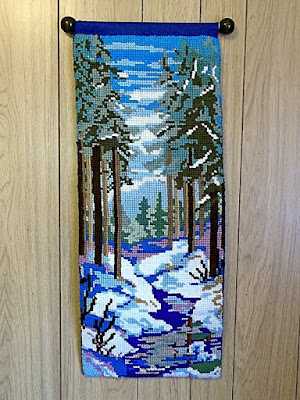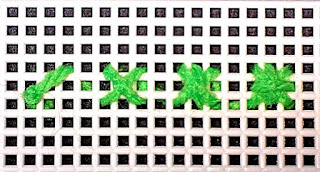Quickpoint is a form of needlework that I recommend to several groups of people. First of all, to beginning needleworkers. It is easy to do and the results are achieved quickly. Almost any kind of design can be adapted to the technique. There are some absolutely beautiful pillow kits currently available that originated in Belgium. You may not want to start out with something quite that expensive, however. You also know, if you are a regular reader of this blog, that I feel kits sometimes discourage creativity.* I would personally rather see all craftspeople do something that is original and that expresses their tastes and personalities. A second group for whom quickpoint is appropriate is that of creative people who have very limited time to do projects. The final group would be those people who once enjoyed needlework, but now find their eyes and hands do not respond as well as they once did. I belong to that group myself. Please don't give up an activity that you love. Find less physically demanding ways to work. Quickpoint is large and the canvas mesh is easy to see. The needles are large and have eyes that are easy to thread. The yarns are thick and cover the canvas quickly. Projects can be any size that is easy for you to hold.
 |
| Quickpoint wall hanging, "Spring Thaw" |
 |
| #3.75 & #5 canvas |
| Framed needlework, "Are You Endangered, Too?" |
From time to time, I create a needlework picture for a series I call “Close Encounters”. The photograph at the beginning of this post is a close-up of one of these pictures, entitled “Are You Endangered, Too?” You can see the entire picture at the right. It is done primarily in cross-stitch with some tent stitch.
| Framed quickpoint, "Let's Do Lunch" |
Tip: If you are doing a framed picture or a wall hanging that you want to stay rigid and not sag, you need to work on jute canvas. To do a pillow or other soft object, you will need cotton canvas or a nylon mesh. Again, you may have to do some searching to find the appropriate materials.
 |
| Quickpoint cross-stitched butterfly |
Here is one last example of combined quickpoint. The butterfly was done in cross-stitch. The outlining is done in a single strand of crewel yarn, as are the “floating” lines that represent veins in the wings. The background is done in tent stitch. This is easier to see in the enlargement below.
| Annake working on "Spring Thaw" |
In the meantime, think “big stitches” and do a little quickpoint.
* My apologies if I have offended anyone from Belgium. I have many fond memories of the country and its friendly people.
 This post by Annake's Garden is licensed under a Creative Commons Attribution-NonCommercial-ShareAlike 3.0 Unported License.
This post by Annake's Garden is licensed under a Creative Commons Attribution-NonCommercial-ShareAlike 3.0 Unported License.


Is quick point like counted cross stitch or is a patteren stamped on the canvas?
ReplyDeleteCan a project of quuickpoint doing in needlepoint instead?
ReplyDelete